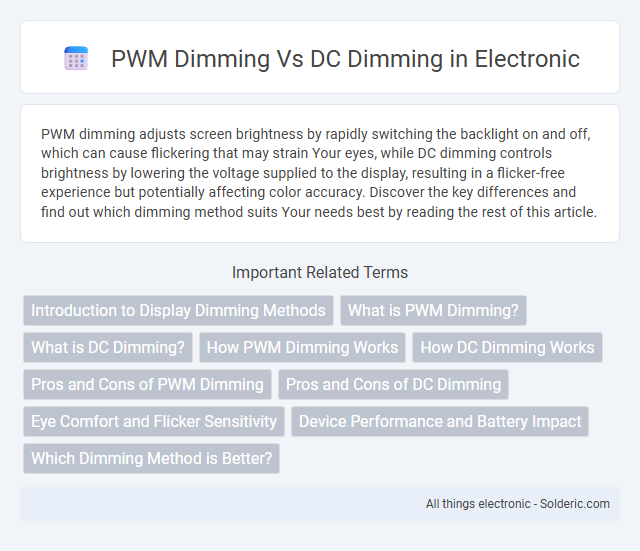PWM dimming adjusts screen brightness by rapidly switching the backlight on and off, which can cause flickering that may strain Your eyes, while DC dimming controls brightness by lowering the voltage supplied to the display, resulting in a flicker-free experience but potentially affecting color accuracy. Discover the key differences and find out which dimming method suits Your needs best by reading the rest of this article.
Comparison Table
| Feature | PWM Dimming | DC Dimming |
|---|---|---|
| Definition | Adjusts brightness by rapidly switching the LED on/off. | Controls brightness by varying the LED's current voltage. |
| Brightness Control | Uses pulse width modulation frequency. | Decreases voltage to lower brightness smoothly. |
| Flicker | May cause visible flicker, leading to eye strain. | Flicker-free, more comfortable for eyes. |
| Power Efficiency | High, due to efficient on/off switching. | Moderate, as current is constantly flowing. |
| Color Accuracy | Consistent color output at various brightness levels. | Possible color shifts at lower brightness. |
| Complexity | Requires PWM controller and circuitry. | Requires precise current regulation circuitry. |
| Application | Common in smartphones, monitors, and LEDs. | Used in OLED displays and eye-comfort focused devices. |
Introduction to Display Dimming Methods
PWM dimming controls display brightness by rapidly switching the backlight on and off at varying duty cycles, preserving color accuracy but potentially causing flicker visible to sensitive users. DC dimming adjusts the direct current supplied to the display panel, reducing brightness smoothly without flicker but sometimes leading to color distortion or inaccurate brightness levels at low settings. Understanding these methods is essential for optimizing display performance, power consumption, and user comfort in devices like smartphones and monitors.
What is PWM Dimming?
PWM dimming (Pulse Width Modulation) controls screen brightness by rapidly switching the backlight on and off at varying intervals, adjusting the duty cycle to reduce perceived brightness. This method allows for precise brightness levels without altering the color accuracy of your display. Understanding PWM dimming is essential if you are sensitive to flicker, as it can affect eye comfort during extended screen use.
What is DC Dimming?
DC dimming adjusts the brightness of your display by directly reducing the voltage supplied to the screen's LEDs, resulting in a stable and flicker-free viewing experience. Unlike PWM dimming, which rapidly switches the LED power on and off to control brightness, DC dimming maintains a consistent current level, minimizing eye strain and headache risks associated with screen flicker. This technology is especially beneficial for users sensitive to screen flicker or those who use their devices for extended periods.
How PWM Dimming Works
PWM dimming modulates brightness by rapidly switching the LED on and off at a high frequency, controlling the perceived light intensity through duty cycle adjustment. This method allows precise control of brightness without altering the LED's color temperature, making it popular in display and lighting technologies. Your device benefits from PWM dimming's efficiency and color consistency during varied brightness levels.
How DC Dimming Works
DC Dimming works by adjusting the voltage supplied to the display's backlight, thereby controlling brightness through direct current variation without flickering. This method reduces eye strain by providing a more stable light output compared to Pulse Width Modulation (PWM) dimming, which rapidly switches LEDs on and off. Your device's screen can achieve smoother brightness levels with DC Dimming, enhancing visual comfort during prolonged use.
Pros and Cons of PWM Dimming
PWM dimming offers precise brightness control and energy efficiency by rapidly switching the LED on and off at high frequencies, minimizing power consumption and heat generation. However, it can cause flicker that may lead to eye strain or headaches, especially at lower brightness levels and for sensitive individuals. The method also may interfere with high-speed cameras and certain sensors due to its pulsing nature.
Pros and Cons of DC Dimming
DC dimming offers smooth brightness adjustment by directly reducing the voltage supplied to the display, minimizing flicker and eye strain compared to PWM dimming. However, it can cause slight color distortion or brightness inconsistencies at lower voltage levels, impacting image quality. Your device's performance may benefit from DC dimming in low-light conditions, but color accuracy might be compromised.
Eye Comfort and Flicker Sensitivity
PWM dimming rapidly switches the backlight on and off to control brightness, which can cause noticeable flicker and strain for sensitive eyes, especially at lower brightness levels. DC dimming adjusts the current supplied to the backlight smoothly, reducing flicker and providing a more stable light source that enhances eye comfort during prolonged use. When considering your display settings, opting for DC dimming can significantly minimize eye fatigue by maintaining consistent illumination levels without the pulsing effect inherent in PWM.
Device Performance and Battery Impact
PWM dimming modulates brightness by rapidly switching the backlight on and off, which can cause flickering and potentially strain your eyes over prolonged use, while DC dimming adjusts brightness by altering the direct current, providing a smoother visual experience. Device performance with PWM dimming may include minor power savings but can lead to increased electromagnetic interference, whereas DC dimming generally offers more stable performance with reduced flicker-related strain. In terms of battery impact, DC dimming typically consumes slightly more power at lower brightness levels compared to PWM, but its overall effect on battery life is minimal and often outweighed by improved user comfort.
Which Dimming Method is Better?
PWM dimming offers precise brightness control by rapidly switching the backlight on and off, minimizing color distortion and enhancing power efficiency in OLED and LCD screens. DC dimming adjusts the backlight voltage, reducing flicker and eye strain but may cause color shifts and uneven brightness at lower levels. For users prioritizing color accuracy and smoother visuals, PWM dimming is generally better, whereas DC dimming suits those sensitive to screen flicker.
PWM Dimming vs DC Dimming Infographic

 solderic.com
solderic.com